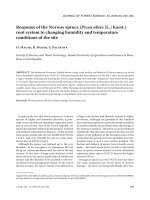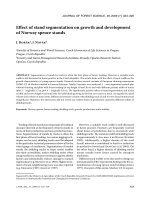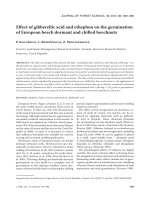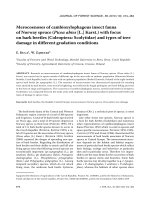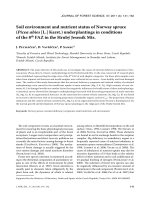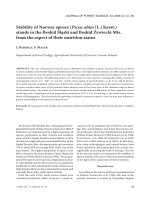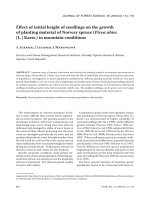Báo cáo lâm nghiệp: "Effect of initial height of seedlings on the growth of planting material of Norway spruce (Picea abies [L.] Karst.) in mountain conditions" ppsx
Bạn đang xem bản rút gọn của tài liệu. Xem và tải ngay bản đầy đủ của tài liệu tại đây (618.62 KB, 7 trang )
112 J. FOR. SCI., 55, 2009 (3): 112–118
JOURNAL OF FOREST SCIENCE, 55, 2009 (3): 112–118
The reforestation of exposed mountain locali-
ties is more difficult than current forest regenera-
tion at lower locations. e growing season in the
mountains is shorter, with lower temperatures and
long-lasting snow cover. Young trees may often be
deformed and damaged by slides of snow layers in
the course of thaw. Shoots projecting over the snow
cover are damaged mechanically by snow and ice
particles drifted by the wind. In bright weather when
the soil is still too cold and the roots cannot take up
water sufficiently, there occurs physiological (winter)
drying up of sunlit shoots. Temperature extremes in
the form of late or early frosts are also frequent.
Specific mountain conditions make greater de-
mands on the choice and preparation of planting ma-
terial that will survive and grow in such a frequently
extreme environment. e relevant genetic quality
of seed is self-evident.
Compared to spruce from lower altitudes, moun-
tain populations of Norway spruce (Picea abies [L.]
Karst.) are characterized by higher variability of
seed and seedlings (K 1998), and by different
growth intensity (M 1985; P 1990; K-
1998; O et al. 1998) and growth rhythm
(L 1989; W et al. 1999; H, W
2000; W et al. 2000b; M, E
2002). When seedlings are grown in constant condi-
tions, there also exist differences in growth intensity
and dynamics (H 1985; H et al. 1987).
Growth differences between spruce populations
originating from various altitudes and grown in the
same environment are the most marked in the first
years of seedling life (H 1985; Q
et al. 1995).
e lower growth intensity of mountain spruce
populations seems to be connected with their in-
Supported by the Ministry of Agriculture of the Czech Republic, Research Plan No. 002070202 Stabilization of Forest Functions
in Anthropically Disturbed Biotopes in Changing Environmental Conditions.
Effect of initial height of seedlings on the growth
of planting material of Norway spruce (Picea abies
[L.] Karst.) in mountain conditions
A. J, J. L, J. M
Forestry and Game Management Research Institute, Strnady, Opočno Research Station,
Opočno, Czech Republic
ABSTRACT: Common ways of nursery cultivation and sorting the planting material of mountain provenances of
Norway spruce (Picea abies [L.] Karst.) are connected with the risk of undesirable narrowing of the genetic spectrum
of populations. Investigations in spruce plantations established by different planting materials found out very good
growth (total height is 125 cm 9 years after outplanting) and health status of these slowly growing seedlings planted
in extreme mountain conditions. In order to prevent the genetic spectrum narrowing, we recommend to cultivate all
seedlings including smaller outsorted (commonly culled) ones. e smallest seedlings can be grown one year longer
and subsequently planted out in the same locality as the remaining planting material of the same seed lot.
Keywords: Norway spruce; mountain conditions; mountain populations; reforestation
J. FOR. SCI., 55, 2009 (3): 112–118 113
creased adaptation to adverse mountain conditions
(O et al. 1998). It is also confirmed by data
documenting that spruce populations from higher
altitudes or northerly areas showed higher resistance
to both frost (S 1994; H, S
2000; W et al. 2000a) and drought (M-
, E 2002) than seedlings from lower
altitudes or of southerly provenance.
Small seedlings characterized by slow growth in
the first years after sowing, which are discarded in
nurseries as culls in the course of current sorting,
may be a very valuable part of the population from
genetic aspects.
High growth variability within mountain spruce
populations is mostly attributed to high genetic vari-
ability of seed. e spruce at various altitudes above
sea level blossoms approximately at the same time and
the pollen is borne across a wide range of altitudes. It
may result in the pollination of spruce populations in
the mountains by pollen from medium altitudes and
vice versa (H 1985). When growing the plant-
ing material for higher mountain altitudes, different
criteria should be used for the sorting of seedlings
and plants because the discarding of smaller, slowly
growing plants may lead to the narrowing of the
genetic spectrum and the plants that have adapted
themselves to extreme mountain conditions in the
best way might be culled (H et al. 1987; L
1989; J, M 1996, 2001).
e aim of the experiment is to investigate the devel-
opment of slowly growing seedlings from a mountain
population of Norway spruce after their planting in
extreme mountain conditions compared to the develop-
ment of seedlings of standard and large dimensions.
MATERIAL AND METHODS
Seeds used for the cultivation of planting mate-
rial originated from the spruce forest vegetation zone
(this zone is characterized by altitude 1,050–1,350 m
above sea level with average temperature 2.5–4°C).
In 1992 two-years-old seedlings were divided before
transplanting into 3 size categories: smaller than 8 cm
(small, usually considered as culls), 8–15 cm (medium)
and 15–22 cm (large). Seedlings reaching just the
height of 8 or 15 cm were included in the higher size
category. After transplanting the plants were grown for
another 2 years, then they were used for direct planting
or they were put into Jiffy pots. Table 1 shows basic
morphological characteristics of four-year plants.
In 1994 the above-described planting material was
set out in a model mountain area of the Krkonoše
Mts. on the slope of Stoh Mt. at a height of 1,000 to
1,100 m above sea level (open area plot 2 ha in size,
acid mountain spruce forest type, north-north-east
orientation, slope of 25–30 grades).
A part of the plants was set out as bare-rooted ones
(2 + 2) in spring 1994, the other part of the variants
“small” and “medium” was put into containers (Jiffy
pots) and set out onto the same research plot in
summer of the same year as containerized planting
material (2 + 2 + c0.5). Particular treatments were
planted to 5 subplots by 100 plants. e distance
between plants was 1.5 m.
Table 1. Morphological characteristics of four-years-old Norway spruce (Picea abies [L.] Karst.) plants used for planting
or put into Jiffy pots (spring 1994)
Variant Size at the time of transplanting
Shoot height
(cm)
Root collar diameter
(mm)
Sturdiness
(height/diameter)
Small smaller than 8 cm
mean 23.8 a 5.8 a
4.08
S
x
7.39 1.71
n 109 109
Medium 8–15 cm
mean 33.8 b 6.8 b
4.99S
x
8.48 1.72
n 112 112
Large 15–22 cm
mean 36.3 b 7.8 c
4.66
S
x
10.17 1.77
n 110 110
e letters in columns indicate statistically significant differences at a 5% significance level (Student’s t-test for unequal
sample sizes and equal variance)
114 J. FOR. SCI., 55, 2009 (3): 112–118
Table 2. Development of basic morphological characteristics in the size categories of Norway spruce (Picea abies [L.]
Karst.) after planting to an extreme mountain locality (1994 plantation)
Measured
characteristic
Year
Variant
Bare-rooted Containerized (Jiffy pots)
small medium large small medium
size at the
time of
transplanting
smaller than
8 cm
8–15 cm 15–22 cm
smaller than
8 cm
8–15 cm
Height (cm)
1995
mean 28.8 a 46.2 b 51.3 c 31.7 a 41.8 b
S
x
8.290 8.367 8.936 7.579 8.791
n 94 93 92 80 94
2000
mean 71.4 a 69.6 a 68.1 a 80.3 a 73.4 a
S
x
21.870 21.968 18.039 23.621 26.857
n 80 93 70 80 91
2003
mean 125.3 b 129.7 b 101.2 a 154.5 b 132.1 a
S
x
46.159 43.964 42.623 35.627 48.135
n 64 75 63 71 88
Height
increment
(cm)
1995
mean 4.1 a 4.0 a 3.7 a 3.9 a 3.7 a
S
x
2.910 3.030 1.861 2.123 2.508
n 94 93 90 80 94
1996
mean 3.7 c 2.6 b 1.8 a 5.5 b 3.9 a
S
x
2.951 1.823 1.051 3.080 4.047
n 84 91 92 82 95
1999
mean 10.0 b 6.1 a 5.4 a 11.8 b 7.7 a
S
x
5.438 4.412 4.624 5.621 5.480
n 86 95 73 82 83
2004
mean 21.7 c 12.1 b 7.9 a 18.9 b 14.4 a
S
x
14.035 7.400 6.156 11.538 8.692
n 60 72 71 81 80
Root collar
diameter
(mm)
1995
mean 6.4 a 8.7 b 11.3 c 7.5 a 8.4 b
S
x
1.901 1.504 2.018 2.120 1.792
n 52 64 50 50 64
1998
mean 9.5 a 8.5 a 13.4 b 13.2 a 13.3 a
S
x
2.727 2.659 3.664 4.612 3.516
n 32 33 32 32 32
2000
mean 14.3 a 12.9 a 14.1 a 16.3 a 18.3 a
S
x
5.354 4.877 4.662 4.998 7.067
n 32 30 32 32 31
2004
mean 36.6 b 35.0 a 27.4 a 38.7 a 43.7 a
S
x
13.296 9.928 12.860 12.657 12.131
n 28 30 30 30 28
e letters in rows (treatments) indicate statistically significant differences at a 5% significance level (Student’s t-test for
unequal sample sizes and equal variance – separately for bare-rooted and containerized plants)
J. FOR. SCI., 55, 2009 (3): 112–118 115
In the growing-up plantation growth and health
of spruces of the described size categories have been
repeatedly examined since 1995. Height and collar
diameter growth (in cm) and health condition (as
percentage of foliage in 10% intervals) were assessed
always in autumn; the height increment was mea-
sured every year as one-year increment. Statistical
significance was evaluated by Student’s t-test for un-
equal sample sizes and equal variance by comparison
to p-value for 95% significance.
RESULTS
Height and diameter growth
e initial average tree height of variant “small”
was 24 cm and 11 years later it increased to 125 cm.
e average height of “large” plants increased at the
same time from 36 cm to 101 cm (Fig. 1). e same
trend was observed in diameter growth (Fig. 2).
Initially slowly growing seedlings of spruce from the
mountain localities (spruce vegetation zone) that are
discarded by the current method of sorting before
transplanting, grow up very well after being set out
in a mountain environment. After they had overcome
the transplant shock, their relative height and diam-
eter growth was more intensive compared to larger
plants. On the contrary, plants of the “large” category
produced from dominant seedlings lagged behind
markedly in their height and diameter growth after
transplanting into mountain conditions. In six years
after planting the initial statistically significant differ-
ences between the categories were fully wiped out,
and after another four years the plants grown from
slowly growing seedlings were significantly higher
and more robust than the plants grown from the larg-
est seedlings (Table 2). e same trend was observed
both in bare-rooted and in containerized plants. In
the last year of investigation (i.e. 10 years after plant-
ing) the mean height increment of plants in variant
“small” was 22 cm and in variant “large” 8 cm.
We found the significantly faster height growth
of containerized plants of the “small” variant in the
first five years after planting compared to the same
size variant of bare-rooted plants and to plants of
the “medium” variant (Fig. 3). During five years
these plants overtook the initially higher plants of
the “medium” variant by their height. Eleven years
after outplanting, the average tree height in variant
“small” was 154 cm while in variant “medium” it was
only 132 cm.
Health condition
e mean foliage of trees in the plantation from
seedlings of the categories “small”, “medium” and
0
20
40
60
80
100
120
140
160
1994 1996 1998 2000 2002 2004 2006
Height (cm)
small medium large
0
5
10
15
20
25
30
35
40
1994 1996 1998 2000 2002 2004 2006
Root collar diameter (mm)
small medium large
Fig. 1. Height growth of the sorted plant-
ing material of Norway spruce (Picea
abies [L.] Karst.) in the course of 11 years
after planting to a mountain locality
Fig. 2. Diameter growth of the sorted
planting material of Norway spruce
(Picea abies [L.] Karst.) in the course
of 11 years after planting to a mountain
locality
116 J. FOR. SCI., 55, 2009 (3): 112–118
“large” was in the first year after outplanting 95%,
73% and 70%, respectively. During the next four
years it decreased to 78%, 61% and 50% and after
overcoming the transplant shock the mean foliage
increased again to 98%, 86% and 89%, respectively
(11 years after outplanting).
e differences between category “small” and other
categories (“medium“ and “large”) were significant in
the whole period of observation while the differences
between category “medium” and category “large”
were found insignificant (Fig. 4).
DISCUSSION
e results document very good growth and health
of plants produced from small seedlings, i.e. seed-
lings characterized by slow growth in the first years
after sowing. Hence these plants represent a very
valuable part of Norway spruce seed lots originat-
ing from mountain areas. Among others, it confirms
the conclusions drawn by H et al. (1987) and
L (1989) about the need of a specific approach to
the sorting of seedlings of Norway spruce mountain
populations in nurseries. When the planting material
of Norway spruce originating from higher mountain
altitudes is grown, the technology of sorting in a
nursery should be modified so that transplants will
be produced from these small seedlings that will be
set out in mountain localities.
e results of investigations in a model plantation
in the Krkonoše Mts. agree with the finding that the
slow growth of a part of the population of spruce
seedlings is the most marked in the first years after
sowing and later it catches up with the rest of seed-
0
20
40
60
80
100
120
140
160
180
200
1994 1996 1998 2000 2002 2004 2006
Height (cm)
small bare medium bare
small Jiffy medium Jiffy
0
10
20
30
40
50
60
70
80
90
100
1995 1996 1998 2000 2002 2004
Foliage (%)
small medium large
Fig. 4. Health status expressed as an average percentage of foliage in the Norway spruce (Picea abies [L.] Karst.) planting mate-
rial sorted by height in the course of 11 years after planting to a mountain locality. Vertical bars show reliability intervals, the
letters in columns indicate statistically significant differences (1% significance level)
Fig. 3. Comparison of height growth
in bare-rooted and containerized (Jiffy
pots) plants
J. FOR. SCI., 55, 2009 (3): 112–118 117
lings (H 1984; M 1985; Q
et al. 1995).
They also confirm an assumption that in the
process of adaptation to adverse environmental
conditions at higher altitudes spruce populations
gain their resistance to the account of growth (M-
1995; O et al. 1998).
e results from the Krkonoše Mts. also support
the conclusions of some authors from the Alps Mts.
area that high-elevation spruce provenances may
partly be pollinated with pollen from medium alti-
tudes and that such pollination markedly contributes
to the high interprovenance variability of height
growth of spruce mountain populations. Because
the seedlings originating from pollination with pol-
len of high-elevation trees are generally smaller, the
discarding of small seedlings in the course of sorting
in a nursery may have a negative influence on genetic
heterogeneity (H 1985). e individuals with
the best adaptation to growth in extreme mountain
conditions, capable of surviving extreme climatic
fluctuations that may occur once in several tens of
years, are likely to be discarded (L 1989).
The results confirm well-known facts that the
transplant shock is reduced and initial growth after
planting is accelerated if a containerized planting
material is used (L 1990). However, they
point to the need to use optimum growing technolo-
gies, in this case the adequate size of plants to be put
into containers (D et al. 1987). A comparison of
the growth of containerized and bare-rooted plants
indicates that the growth of small plants in the first
years after planting may be stimulated by the use
of containerized planting material. e stimulating
effect of Jiffy pots was not evident in plants of the
“medium” variant that were relatively large when
they were put into these containers and so such an
operation was a stronger intervention in their root
systems and deteriorated the shoot to root ratio.
Plants of the “large” variant were not suitable to be
put into Jiffy pots due to their size and therefore no
containerized plants were used in this variant.
ere arises a question in what seedlings the slow
growth is caused genetically and balanced by higher
resistance to adverse mountain conditions and what
seedlings are really to be considered as culls.
CONCLUSIONS
e monitoring of plantations on mountain re-
search plots in the course of 10 years showed that
the outplantings established from seedlings grow-
ing slowly in a nursery and discarded as culls by a
current sorting method (designated as “small”) were
vigorous in mountain conditions and their growth
was good.
Initial height differences from plants growing
faster in a nursery were gradually reduced.
e health status of plantations from the seedling
category “small”, characterized by foliage and fre-
quency of occurrence of colour changes of needles,
is better than in plantations from larger categories.
Implications for forest practice
e discarding of these plants growing rather slow-
ly in nurseries may pose a risk of impoverishment of
the natural spectrum of individuals well adapted to
extreme conditions of mountain localities.
When growing the planting material of spruce
from the mountain localities, technologies used in
tree nurseries should be modified to produce and
to use the whole growth spectrum of seedlings and
plants for setting out to clear-cut areas. e possible
way is to put small plants into suitable containers
(Jiffy pots) and to set them out subsequently in the
same locality as the remaining planting material of
the same seed lot.
R efe re nc es
DUŠEK V., MARTINCOVÁ J., JURÁSEK
A., 1987. Pokyny
pro pěstovaní obalených semenáčků a sazenic. Lesnický
průvodce. Strnady, VÚLHM, 2: 34.
HANNERZ M., WESTIN J.,
2000. Growth cessation and
autumn-frost hardiness in one-year-old Picea abies prog-
enies from seed orchards and natural stands. Scandinavian
Journal of Forest Research, 15: 309–317.
HAWKINS C.D.B., SHEWAN
K.B., 2000. Frost hardiness,
height, and dormancy of 15 short-day, nursery-treated
interior spruce seed lots. Canadian Journal of Forest Re-
search, 30: 1096–1105.
HOLZER
K., 1985. Die Bedeutung der Genetik für den Hoch-
lagenwaldbau. In: Establishment and Tending of Subalpine
Forest. Proceedings 3
rd
IUFRO Workshop, Birmensdorf,
Eidgenössiche Anstalt für das forstliche Versuchswesen.
Berichte, Nr. 270: 225–232.
HOLZER K., SCHUTZE U., PELIKANOS V., MÜLLER
F.,
1987. Stand und Problematik der Fichten – Stecklingsver-
mehrung. Österreichische Forstzeitung, 98: 12–13.
JURÁSEK
A., MARTINCOVÁ J., 1996. Problematika aklima-
tizace a specifického růstu sadebního materiálu horského
smrku. In: VACEK S. (ed.), Monitoring, výzkum a manage-
ment ekosystému na území Krkonošského národního parku.
Sborník z konference, Opočno, 15.–17. 4. 1996. Opočno,
VÚLHM, VS Opočno: 133–141.
JURÁSEK
A., MARTINCOVÁ J., 2001. Vliv místa školky,
způsobů pěstování a třídění na růst sazenic horského
118 J. FOR. SCI., 55, 2009 (3): 112–118
smrku po výsadbě na holiny. Opera Corcontica, 37, 2.
Geoekologické problémy Krkonoš. Sborník z mezinárodní
konference, Svoboda nad Úpou, 19.–21. 9. 2000. Vrchlabí,
Správa Krkonošského národního parku: 608–615.
KOTRLA P., 1998. Uchování a reprodukce genofondu
původních populací smrku 8. lesního vegetačního stupně
v Hrubém Jeseníku a Kralickém Sněžníku. [Dizertační
práce.] Brno, MZLU: 139.
LANG
H.P., 1989. Risks arising from the reduction of genetic
variability of some Alpine Norway spruce provenances by
size grading. Forestry Supplement, 62: 49–52.
LOKVENC
T., 1990. Poznatky se zaváděním obalené sadby,
zejména typu Jiffy pots v ČR. In: Technika obalované
sadby. Mezinárodní konference Jiffy Research and Ser-
vice, Špindlerův Mlýn 18.–19. 9. 1990. Hradec Králové,
Východočeské státní lesy: 9.
MAUER
O., 1985. Pěstování sadebního materiálu horského
a vysokohorského ekotypu smrku v Jeseníkách a Beskydech.
[Závěrečná výzkumná zpráva.] Brno, VŠZ: 40.
MODRZYNSKI J., 1995.
Altitudinal adaptation of Norway
spruce (Picea abies (L.) Karst.) progenies indicates small
role of introduced populations in Karkonose Mountains.
Silvae Genetica, 44: 70–75.
MODRZYNSKI J., ERIKSSON
G., 2002. Response of Picea
abies populations from elevational transects in the Polish
Sudety and Carpathian mountains to simulated drought
stress. Forest Ecology and Management, 165: 105–116.
OLEKSYN J., MODRZYNSKI J., TJOELKER M.G.,
ZYTKOWIAK R., REICH P.B., KAROLEWSKI P.,
1998.
Growth physiology of Picea abies populations from eleva-
tional transects: common garden evidence for altitudinal
ecotypes and cold adaptation. Functional Ecology, 12:
573–590.
POPOV
E., 1990. Influence of seed origin of Pseudotsuga
menziesii on the height growth, terminal bud formation,
and frost resistance of one-year seedlings. Nauka za Gorata,
27: 3–17.
QUAMARUDDIN M., EKBERG I., DORMLING I., NORELL
L., CLAPHAM D., ERIKSSON
G., 1995. Early effects of
long nights on budset, bud dormancy and abscisic acid
content in two populations of Picea abies. Forest Genet-
ics, 2: 207–216.
SIMPSON
D.G., 1994. Seasonal and geographic origin effects
on cold hardiness of white spruce buds, foliage, and stems.
Canadian Journal of Forest Research, 24: 1066–1070.
WESTIN J., SUNBLAD L.G., STRAND M., HÄLLGREN J.E.,
1999. Apical mitotic activity and growth in clones of Norway
spruce in relation to cold hardiness. Canadian Journal of
Forest Research, 29: 40–46.
WESTIN J., SUNBLAD L.G., STRAND M., HÄLLGREN J.E.,
2000a. Phenotypic differences between natural and selected
populations of Picea abies. I. Frost hardiness. Scandinavian
Journal of Forest Research, 15: 489–499.
WESTIN J., SUNBLAD L.G., STRAND M., HÄLLGREN J.E.,
2000b. Phenotypic differences between natural and selected
populations of Picea abies. II. Apical mitotic activity and
growth related parameters. Scandinavian Journal of Forest
Research, 15: 500–509.
Received for publication September 25, 2008
Accepted after corrections October 29, 2008
Corresponding author:
Doc. Ing. A J, Výzkumný ústav lesního hospodářství a myslivosti, v.v.i., Strnady,
Výzkumná stanice Opočno, Na Olivě 550, 517 73 Opočno, Česká republika
tel.: + 420 494 668 391, fax: + 420 494 668 393, e-mail:
Vliv počáteční výšky semenáčků na růst výsadeb smrku ztepilého
(Picea abies [L.] Karst.) v horských podmínkách
ABSTRAKT: Běžný způsob pěstování a třídění sadebního materiálu smrku ztepilého (Picea abies [L.] Karst.) v les-
ních školkách je spojeno s rizikem nežádoucího zúžení genetického spektra kultur. Šetření ve smrkových kulturách,
založených výsadbou specificky tříděného sadebního materiálu do extrémních horských podmínek, ukázala velmi
dobrý zdravotní stav sazenic vyznačujících se pomalým růstem ve školce. Jako prevenci zužování genetického spektra
horských populací smrku ztepilého doporučujeme dopěstování všech semenáčků včetně těch, které jsou při běžném
způsobu třídění vyřazovány jako výmět. Nejmenší jedinci přitom mohou být pěstováni o rok déle a následně vysa-
zováni na stejnou lokalitu jako ostatní sazenice ze stejného oddílu.
Klíčová slova: smrk ztepilý; horské podmínky; horské populace; zalesňování

